FUD UNIT 3.3
1/47
There's no tags or description
Looks like no tags are added yet.
Name | Mastery | Learn | Test | Matching | Spaced |
|---|
No study sessions yet.
48 Terms
ITALIAN RENAISSANCE
(1400-1650)
GOAL IN DESIGN: More social interaction and entertainment
• Furniture were generally
placed against the wall.
• It made a dominant part of the
wall composition along with
wall plaques, busts, and
paintings.
It was large with rectilinear lines
• It featured classic motifs in high
relief.
• There were numerous pieces on low
pedestals.
• Seats were upholstered.Walnut was used almost exclusively,
except for small amount of oak, cedar
and cypress.
• Furniture was used sparingly.
• Silk textiles with large patterns were
used for upholstery.
• There was a variety of furniture
pieces.
CASSONE/ CASSONI
- The most important piece of
Italian Renaissance furniture was a hinged chest
or storage box.
- Its size varied from a jewel casket to
the almost immovable dower chest, and
it often doubled as luggage.
- It is used to store clothing and other
items like seats or tables
.
- were passed from one
generation to the next and many have
survived.
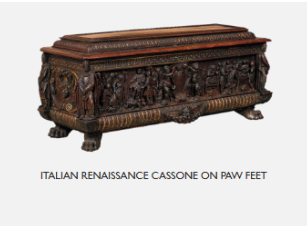
CASSAPANCA
- Some cassoni, were fitted with a back
and arms.
- Considered the forerunners of the
sofa.
- It is usually set upon a dais and had
loose cushion.
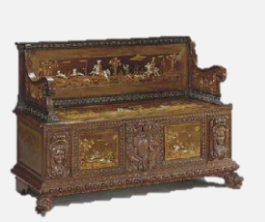
SEDIA
- It was a square, straight chair with low
stretchers or runners
- rear legs that extended to form the back
upright which is usually terminated in an
ornament or finial.
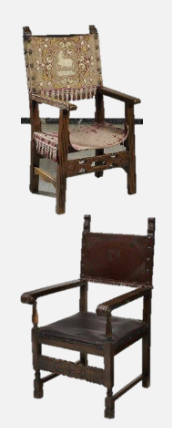
SGABELLO
- A lighter rather uncomfortable wooden
chair.
- It is usually used for dining.
- Early examples had three legs, small
octagonal seats and stiff backs.
- Later ones had elaborately carved trestle
or slat supports and backs.
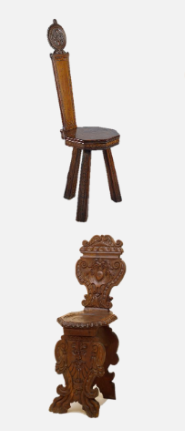
SAVONAROLA CHAIR
X-Shaped Chair
Curved wooden slats attached to
solid arms, and a carved wood seat
and back.
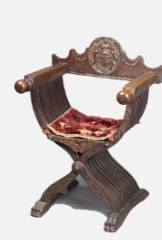
DANTE CHAIR
X-Shaped Chair
Had heavily ornamented arms and
legs.
- A seat and back panel of cloth or
leather.
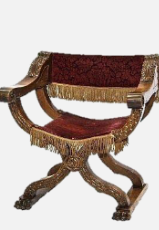
REFECTORY TABLE
- It originated in the monasteries,
typically had an oblong top of a single
walnut plank
- supported by elaborately carved
trestles, dwarf Doric columns, or
turned baluster forms
- with either plain or carved stretchers.
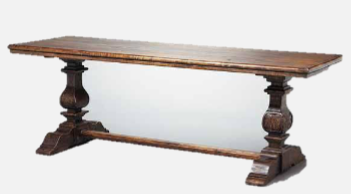
CREDENZA
- It was set on a carved base.
- It had two or three drawers with
doors beneath, and was ornamented
with carving or intarsia.
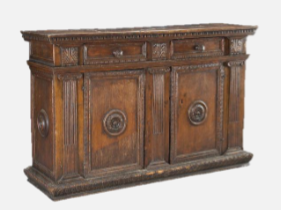
LETTO
- It was a massive structure.
- Often placed on a base
- It had a paneled headboard and
footboard and occasionally a tester.
- The canopy and draperies were of rich,
large patterned velvets, silks, and
damasks.
- Large patterned brocades were
introduced during the latter part of the
period.
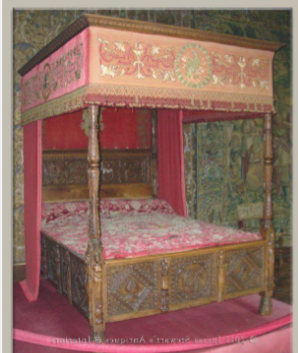
SPANISH RENAISSANCE
GOAL IN DESIGN: Simplicity and Durability
• Furniture were primitive.
• Strength and stability of
construction were increased
by the use of wrought iron
bracing.
• The cabinetmaker’s art was
subservient to the skill of the
inlayer.
• In 1515, the people in
Granada had a law regulating
furniture, workmanship and
materials.
FURNITURE CHARACTERISTICS:
• It has heavy proportions and was
rectangular.
• It was structurally simple, lacking the
architectural details used in Italy.
• It featured iron braces and mounts and
exposed nailheads.
• It was large, masculine, brilliantly
colored (often mask inferior
workmanship).
• Tooled and plain leather upholstery was
used.
• Walnut was the most important
wood, then pine.
• Motifs included short chiseled grooves,
geometric patterns.
• Legs were splayed or slanted.
• Iron and silver rosettes, stars and shells
were used as ornaments
SILLON DE CADERA
Also known as hip-joint chair
- It was the Spanish version of the Dante
or Savonarola chair.
- It usually appeared top- heavy because
the upper part was often larger than the
lower part.
- Inlaid ivory, star motifs, arabesque
designs and decorative nailheads were
typical.
- A decorative boss, or projecting
ornament, was often placed where the
curule legs intersected.
- Heavy fringe, luxurious tassels, and
upholstery were used on these chairs.
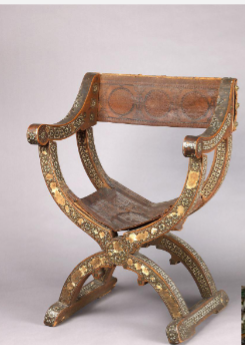
SILLON FRAILERO
- Also known as monk’s chair
- This chair was rectangular, with a
leather, velvet, or damask seat
- a back ornamented with decorative
nailheads.
- The legs extended above the seat
to form arms at the front and the
rear back supports, which often
ended with finials.
- Low stretchers braced the legs and
the broad front stretcher was often
decorated or pierced chiseled
grooves.
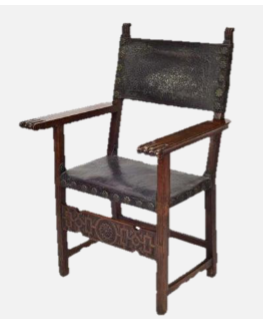
LADDER BACK CHAIR
- With the uppermost back slat
richly carved and larger than the
others.
- It is one of the most popular seats
during this period.
- Legs and stretchers were turned
and the top front stretchers often
repeated the design of the back.
- The seat was usually rush.
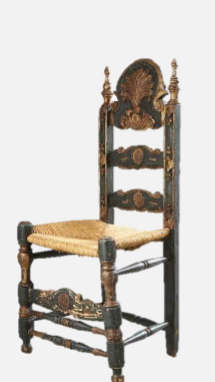
MONASTERY OR SACRISTY BENCH
A long bench with a hinge top was used for
seating and storage.
- These benches might be ornamented with finials,
turned spindles, and heavy carving, or maybe just
plainly decorated.
It was made of two planks one serving
as the seat and the other as a back.
- It had trestle legs and wrought iron
bracing.
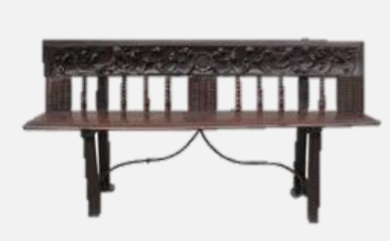
TABLES
- Considered the most important items in the
Spanish Renaissance.
- Usually they had long, plain surfaces with
square-cut edges and long overhanging top.
- had either lyre-shaped testle bases or
four legs- column, spool, or disk-turned. Both
the legs and the trestle were splayed and
braced with wrought iron
VARGUEÑO
- This writing cabinet was a Spanish Renaissance
innovation.
- It was a chest or hutch with a hinged writing
surface that rested on pull-out supports.
- Drawers and secret compartments were in the
interior.
- A lock, keyholes, handles and a large bolt of
wrought iron completed the top.
- The base had trestles or turned legs, braced with
wrought iron.
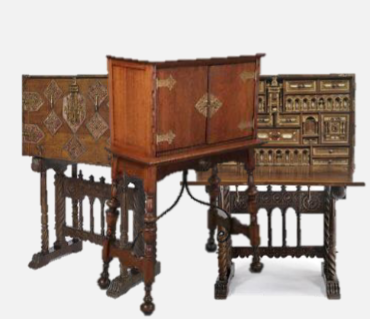
PAPELERA
- It was a smaller chest, without the hinge lid
- used to hold paper and writing materials
- Ivory inlay, shells, fluting, rosettes, and architectural
detailing were used.
- Tables or bases similar to the ones holding the
vargueño were typical.
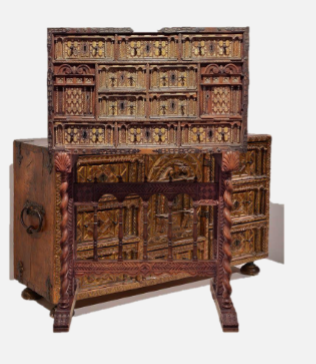
ARMARIA
ARMARIA
- It served as closets.
- Ornamented with geometric patterns
ARCA
It served as a storage chest.
- It was made in all sizes of wood.
- Depending upon its size, it might be mounted on a
separate stand.
Spanish beds
___ beds were made with or without
corner posts, which might be twist- turned.
- Some beds had separate painted headboards of
turned piers and arcades.
- Draperies were very important and rich fabrics
with fringe and tassels were widley used.
FRENCH RENAISSANCE
GOAL IN DESIGN: IDENTITY AND SYMBOLISM
• During the early Renaissance,
there was a scarcity of
ornamented furniture.
• As the period progressed and
prosperity grew, more pieces
appeared.
• People primarily used chests,
beds, and a few chairs.
• Furniture during this period
were massive and elaborately
carved with marble, metal, or
tortoise-shell inlay.
Two innovations of the period
were:
a. Fixed upholstery filled
with horsehair.
b. Development of the
armoire.
• By 16th century, furniture
joints were hidden.
• The use of ebony veneers late
in the period was responsible
for the word “ebeniste”, which
designated the high-quality
cabinetmaker.
Marquetry, the intersection of
contrasting materials into
veneer, appeared, and rules
governing the technique were
laid down by the guilds.
Marquetry of colored wood, tortoise
shell, gilded metal, mother of pearl, ivory
was used.
• Pieces had fixed upholstery of
embossed Cordovian leather, velvet,
needlepoint or petitpoint, damask;
fringe trim.
• Motifs included olive, laurel, or acanthus
leaves; foliated scrolls, arabesques,
rosettes; cartouches, medallions, shells,
chimera, griffins, lozenges, grotesques,
caryatids.
• Furniture joints were concealed.
Marquetry
, the intersection of
contrasting materials into
veneer, appeared, and rules
governing the technique were
laid down by the guilds.
FRENCH RENAISSANCE
What renaissance?
CHEST
Coffers and chests were made until
about 1650.
- It was considered the forerunner of
the commode.
- They followed the Italian style and
many were not portable, being
placed on a platform.
- Every surface was elaborately
carved, and caryatids, columns or
pilasters were added.
- Even at court, many low chests
were still used as seats.
FRENCH RENAISSANCE
What renaissance?
STOOLS AND BENCHES
- With or without backs, were used
throughout the Renaissance.
- Some had hinged seats with a
storage chest underneath.
- Turned legs and upholstered seats
were typical, because there was no
separate dining room.
- Folding stools were often used.
FRENCH RENAISSANCE
What renaissance?
BEDS
- The beds were too monumental to
be moved.
- It had elaborately carved
headboards, posts, cornices and
heavy testers.
- It was designed to be an integral
part of the room.
- It was a symbol of wealth and
leisure.
- The ultimate symbol of rest and
relaxation.
CAQUETOIRE
- Also known as conversation chair.
- Considered the most important chair
during this period.
- The seat was considerably wider in front
than in the back, and the arms curved
inward from the front to the back.
- The legs were usually baluster-turned or
slender columns terminating in bun feet.
- This chair might be compared to the
Italian Sgabello.
- Also for the first time, cane was used as a
material for furniture.
BAROQUE: LOUIS XIV
GOAL IN DESIGN: ELEGANCE
Monumental furniture had to be designed
for massive interiors.
• It was designed for elegance rather than
comfort.
• It was usually placed against the wall-
where it stayed, because it was too heavy
to move.
• Sitting was a ceremonial ritual with a
throne-like chair for the king, stools for
members of the lesser ranks.
FURNITURE CHARACTERISTICS:
• It was monumental, with exaggerated,
massive classic forms
• It was elegant rather than
comfortable, although upholstery was
used.
• It featured straight lines with some
compass curves, and rectangular,
symmetrical structure.
• Oak, walnut, some lime and
pearwood were used, with inlays of
zebra, tulipwood, kingwood
Motifs included sunburst, double L in
oval, satyr mask, C and S curves,
dolphins, sphinxes, lion’s head and
claws, ram’s head or horns, acanthus,
laurel, olive leaf, rinceau, lozenges,
flowers, fruit, birds, butterflies,
palmettes, waterlily leaves irregularly
scattered, human or allegorical figures,
ancient weapons.
Andre Charles Boulle
• He was appointed master cabinetmaker to
Louis XIV in 1672.
• Together with his 4 sons, designed
magnificent furniture inlaid with brass,
pewter, horn, German silver, and tortoise
shell.
• He perfected “ormolu” or gilded
bronzework.
• Ormolu is typical of later French furniture,
changing in scale, subject matter, and motifs.
SEGGIOLONE
- It was a large, imposing chair of
gilded wood.
- It is also called as confession chair,
which was developed about 1673.
- Were upholstered, had wings to
hide the sitter’s face and were used
by priests.
- They had open arms like bergere of
18th century
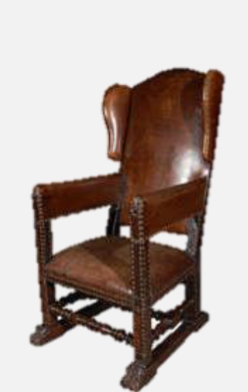
FAUTEUIL
- An upholstered chair with open arms
Gossips
Baroque chairs
- A low-backed chairs which developed
near the end of the period
Cane Chairs
French Baroque chairs
- Were imported for the wealthy
Settee
French Baroque sofa
- With elaborately ornamented back and
X-shaped stretchers, developed from the
day bed.
Cupboard
French Baroque
- storage piece made as imposing as possible, was a symbol of status among ladies
Bookcase Cupboard
- storage piece from baroque period
Imposing piece of furniture often with glass
doors.
Commode
French Baroque
- Became the most important piece of
furniture.
- It was heavy, with compass curves, ormolu,
and marquetry topped with a massive
marble top.
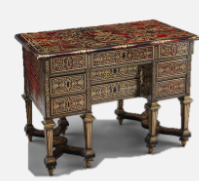
Armoire
- Considered the most important storage
piece
- Usually of ebony veneer with Boulle panels
on the front.
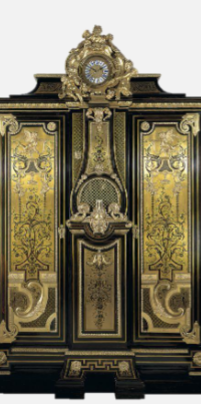
CABARET
- Was the forerunner of the tea table
CONSOLE TABLE
- Decorated on three sides with a fourth
side attached to the wall.
- Surmounted with tall mirrors.
BUREAU
- Another name for a writing table
- Which came into use about 1650, had
drawers, was elaborately ornamented with
marquetry or gilding, and was frequently
surmounted by a mirror.
DUCHESSE BED
- Had only two rear posts with a tester (canopy)
that ran the full length of the bed
DAYBED
- Was large enough to seat two to three people
and later became a settee
FRENCH REGENCE
GOAL IN DESIGN: LUXURY AND
COMFORT
Founding guilds, which were in effect
closed corporations, kept standards
high.
• Known cabinetmakers were J.A.
Meissonier and Charles Cressent
FURNITURE CHARACTERISTICS:
• Carved or cabriole legs appeared.
• Stretchers disappeared as period
progressed.
• Chair top rails and side rails became
slightly curved.
• Arms were set back.
• Pieces were smaller and less bulky.
• Design was less symmetrical.
• Surface ornamentation increased and
ormolu trim appeared.
• Elegant, light cross banding and colorful
exotic veneers were used.
• Oriental influence appeared.
menuisier
– the chair makers
ebenistes
- the cabinet makers
French Regence
Which period?
CHAIRS
- Were the first furniture pieces to
reveal the change in style.
- They became lighter, easily movable,
and more comfortable.
- Backs were lower though still
straight.
- Cabriole legs were ornamented
with a shell or acanthus leaf on the
knee
- Stretchers disappeared or were Z-
formed.
They were upholstered or caned
- Wood was natural walnut, or
painted and gilded.
- The wooden framework of the
chair was visible and curved at the
top.
- Arms, straight or scrolled, were set
back to accommodate ladies’ full
skirts.
- Curved seats replaced the square
seats of the Louis XIV period
(which lasted unitl 1720)
French Regence
Which period?
TABLES
- Free-standing tables no longer had
crossed-stretchers.
- They had baluster, pedestal, or cabriole
legs with hoof or scroll feet.
COMMODES
- Elegant commodes of rare wood veneers
with beautiful ormolu trim were typical of
this style.
- They remained massive and heavy.
- Straight lines were almost completely
eliminated.
- Cabriole legs were typical.